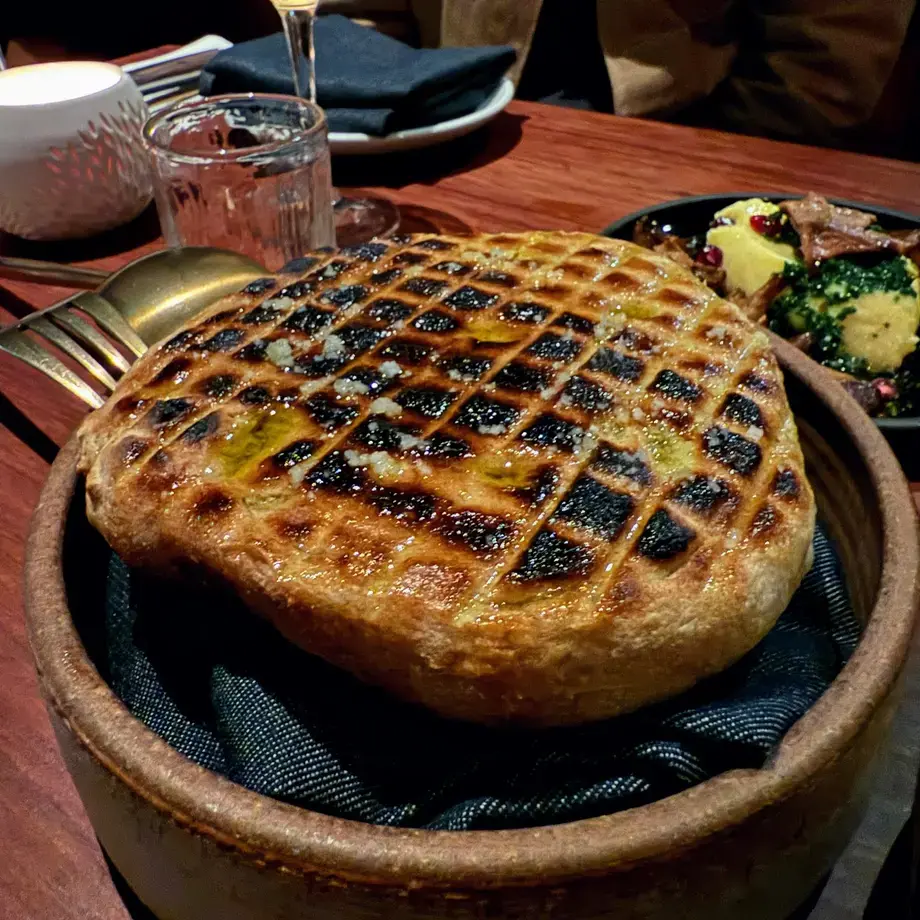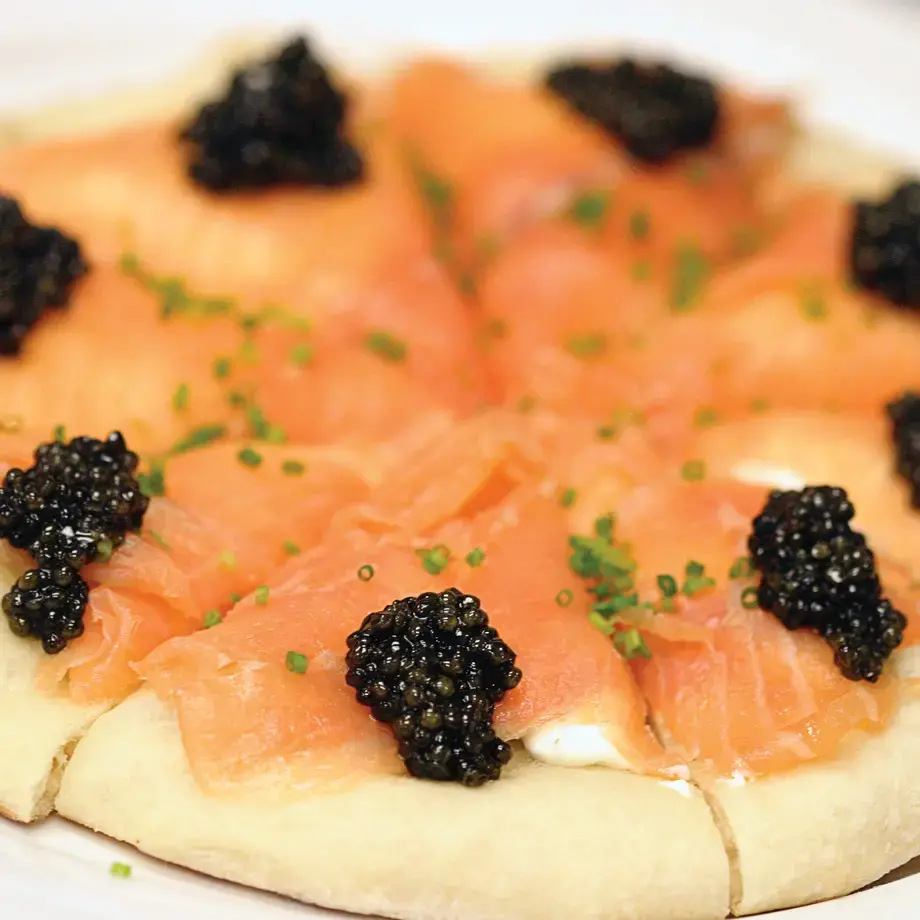This recipe is excerpted from The French Laundry, Per Se by Thomas Keller (Artisan Books). Copyright © 2020.

Excerpted from The French Laundry, Per Se by Thomas Keller (Artisan Books). Copyright © 2020. Photographs by Deborah Jones
Molokai Sweet Potato Mille-Feuille
Clarified butter: 175 g
Molokai sweet potato: 400 g
Russet potato: 200 g
Kosher salt: 8 g
Water: 90 g
Caster sugar: 90 g
Yuzu juice: 30 g
Salt
Asian pears: 1
Sherry vinegar: 100 g plus more to taste
Water: 875 g
Sweet onion essence: 600 g
Mushroom essence: 600 g
Dehydrated caramelized onions: 15 g
Thyme: 7 g
Garlic: 3
Bay: 1
Pre-Hy: 12 g
Kosher salt
Butter: 75 g
Leeks: 100 g diced
Cream: 200 g
Stemmed arrowleaf spinach leaves: 500 g stemmed
Pre-Hy: 8 g
Kosher salt
Potato flakes: 40 g
Cornstarch–egg white paste
Clarified butter: 30 g or more as needed
Follow this step-by-step recipe to make a delicious Molokai Sweet Potato Mille-Feuille at home, for a taste of celebrated chef Thomas Keller.
"This dish originated because of the shape of the vegetables we were using. We’ve always done some form of mille-feuille potato, a shingled or scalloped dish. When we found ourselves with a colorful variety of small marble potatoes, we scalloped them in a sheet pan, making a virtue of their varying sizes and colors. When we discovered the richly flavored purple Molokai sweet potato, we used this same technique. We love its deep coloring, its sweetness, and the savory depth of the spinach, pear, and onion jus that makes this vegetarian dish as satisfying as a meat course".
Method
If you have a chamber vacuum sealer, put an eighth sheet pan in a 12 by 15-inch (30 by 40-centimeter) sous vide bag, place in the sealer chamber, and vacuum seal. If you do not have a chamber vacuum sealer, spray an eighth sheet pan with nonstick spray. Line the pan with two layers of plastic wrap, extending it over the sides.
Put the clarified butter in a wide 3-quart (3-liter) saucepot, heat just enough to melt the butter, and keep warm.
Set a Japanese mandoline over a bowl. Slice the potatoes lengthwise into 1-millimeter-thick (paper-thin) slices. Adjust the blade as necessary to be certain that the slices are solid and of even thickness. Season with the salt. Gently toss the potato slices in the pan with the clarified butter to coat.
Overlap (shingle) the potato slices, alternating between the sweet potatoes and the russet potatoes (use 2 slices of sweet potato, then 1 slice of russet), in even rows to cover the bottom of the prepared sheet pan in a solid layer. Cover the potatoes with a piece of parchment paper, set a second eighth sheet pan on top, and press down to secure the potato slices in place.
Remove the top pan and the parchment and arrange a second layer of potato slices over the first. Continue to layer the potatoes, pressing with the parchment and sheet pan after each layer is complete. The final layer of potatoes should be level with the rim of the pan.
If you have a chamber vacuum sealer, set an immersion circulator in a water bath and heat the water to 88°C (190.4°F). Wrap the entire sheet pan twice in plastic wrap, place it in a 12 by 15-inch (30 by 40-centimeter) sous vide bag, and vacuum seal. Cook in the water bath for 1½ hours. Remove from the water bath and let rest for 15 minutes, then submerge in an ice-water bath until cold. Refrigerate for up to 2 days.
If you do not have a chamber vacuum sealer, preheat the oven to 300°F (150°C). Place a piece of parchment on top of the mille-feuille and seal the pan with a piece of aluminum foil. Bake for about 1 hour, until a cake tester inserted into the potatoes meets no resistance. Remove the foil but leave the parchment over the top. Set a second eighth sheet pan on the parchment and add weight to the pan to compress the potatoes; let stand for about 30 minutes. Transfer the potatoes with the weights to the refrigerator and refrigerate for at least 6 hours or up to 2 days.
Combine the water, sugar, and yuzu juice in a 2-quart (2-liter) saucepot and warm over medium-high heat, stirring often, just enough to dissolve the sugar. Pour the syrup into a bowl and season to taste with sea salt. Nestle the bowl in an ice-water bath and let cool completely.
Peel the pear and slice it just under ¼ inch (6 millimeters) thick on a Japanese mandoline. If you have a chamber vacuum sealer, put the slices of pear and the syrup in a sous vide bag. Place in the sealer chamber and vacuum seal. The pears can be used immediately or refrigerated for up to 3 days. Punch it with a flower-shaped cutter just over ½ inch (13 millimeters) in diameter just before using.
If you do not have a chamber vacuum sealer, punch the pear with a flower-shaped cutter just over ½ inch (13 millimeters) in diameter and place the pieces directly in the syrup. Refrigerate in a covered container for at least 24 hours or up to 3 days.
Reduce the vinegar in a 4-quart (4-liter) saucepot over high heat until the pan is almost dry.
Add the water, onion essence, mushroom essence, dehydrated caramelized onions, thyme, garlic, and bay leaf to the saucepot. Bring to a boil, then reduce the heat and simmer for about 15 minutes.
Place a dampened tea towel in a strainer set over a medium bowl. Strain the liquid into a 2-quart (2-liter) saucepot. Bring to a simmer and reduce to 300 grams.
Strain the liquid into a blender. With the blender running on medium speed, add the Pre-Hy and blend to combine. Season with additional vinegar and salt to taste. Strain through a chinois into a container and cover.
Refrigerate for up to 3 days.
Heat the butter in a 1-quart (1-liter) saucepot over medium-high heat until it begins to brown.
Add the leek to the saucepot and sweat over low heat until tender, about 30 minutes.
Add the cream to the saucepot and bring it to a boil. Cook, stirring often, until the cream mixture is very thick. It will have the consistency of a glaze and look as though it is about to split.
Bring a pot of water to a boil. Blanch the spinach in the boiling water until tender, about 3 minutes. Drain the spinach and transfer to a clean kitchen towel. Wring out any excess moisture. Place 135 grams of the spinach in the blender. Add the glazed leek and Pre-Hy; blend until smooth, using the tamper to help the mixture combine. Taste the creamed spinach and season with salt. Keep in a warm spot for up to 4 hours before serving or transfer to an airtight container and refrigerate for up to 2 days.
Warm the caramelized onion jus and the creamed spinach in separate saucepots, if needed. Fill a disposable piping bag with the creamed spinach and pipe it into a small squeeze bottle.
Remove the mille-feuille from the refrigerator and work with the potatoes while they are cold.
Remove the weights or plastic. Lift the potatoes from the pan and place on a cutting board.
Trim just enough of the mille-feuille to smooth the edges. Cut crosswise in half, then cut each half crosswise into 3 equal portions.
Lightly crush the potato flakes in your hands and place in a shallow bowl. Put the cornstarch paste in a separate shallow bowl. Dip the bottom of each mille-feuille in the cornstarch paste, then dip in the potato flakes to coat.
Heat the clarified butter in a large sauté pan over medium heat. Working in batches, add the mille-feuille to the pan, crust-side down, and sauté for 2 to 3 minutes, until the bottom is golden brown. Transfer the mille-feuille to a cutting board, crust-side down, and cut each piece into 3 equal pieces. Drain briefly on paper towels. Repeat with the remaining mille-feuille. If the mille-feuille have cooled before you’re ready to serve them, transfer them to a rack set over a sheet pan and rewarm in a preheated 375°F (190°C) oven for about 6 minutes, until warmed throughout.
Arrange the mille-feuille on the serving plates. Garnish with pieces of the Asian pear, dots of the creamed spinach, and chrysanthemum shoots. Spoon a few pools of the caramelized onion jus onto each plate.













